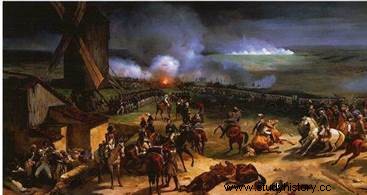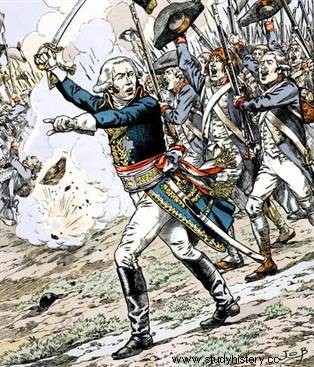 The Battle of Valmy was the first military victory of the French revolutionary army, won against an Austro-Prussian army (reinforced by French emigrants) on September 20, 1792. Against all expectations, after a heavy cannonade, a fine harangue from Kellermann near the famous mill of Valmy, a few brief skirmishes and a demonstration of the Prussian infantry which did not shake the resolve of the French lines, the allies withdrew from the battlefield. Valmy will become a founding symbol, the first victory of revolutionary France against the coalition of European monarchies.
The Battle of Valmy was the first military victory of the French revolutionary army, won against an Austro-Prussian army (reinforced by French emigrants) on September 20, 1792. Against all expectations, after a heavy cannonade, a fine harangue from Kellermann near the famous mill of Valmy, a few brief skirmishes and a demonstration of the Prussian infantry which did not shake the resolve of the French lines, the allies withdrew from the battlefield. Valmy will become a founding symbol, the first victory of revolutionary France against the coalition of European monarchies.
Revolutionary France goes to war
In 1792, three years after the storming of the Bastille and the night of August 4 abolishing privileges, France was still a monarchy framed by the Constitution of 1791, but the king's flight to Varennes where he was recognized (the June 21) will trigger a series of events leading revolutionary France to war against the threatening monarchies of Europe:declaration of war on Austria in April, suspension of the king in August followed by the entry into the territory of one hundred and sixty - ten thousand united and emigrated to France on the 18th.
Bound to counter the Austro-Prussian counter-revolutionary power, France declared war on Emperor Francis II on April 20, 1792. The country was then crossed by the same momentum towards a common cause:the defense of the country and of the Revolution. Exalted by his recent liberation (the fall of Louis XVI and the monarchy, August 10, 1792), part of the people vibrates in unison with patriotic speeches on the infallible victory of the Nation. In the zones of contact with the enemy, the volunteers are numerous, especially from July 1792, after the Assembly had proclaimed the fatherland in danger.
But, despite this momentum, France is on the verge of civil war and its army, ill-prepared, suffers the war. Longwy and Verdun are taken. The enemy armies penetrate deeply, invading Lorraine in mid-August 1792. In Paris, the population is seized with a psychosis of treason and royalist plots. at the beginning of September, bands of killers acting under the authority of the Commune commit massacres in the prisons where the suspects are piled up. The survival of the revolutionary government now depends only on the fate of the arms.
The Battle of Valmy:a simple "cannonade"
 In September, despite the slowness of the coalition invasion, the situation seemed catastrophic and the French army, of the difficult amalgamation between the old royal army and the new volunteers, unable to oppose it. wooded area of the Argonne (natural border between Lorraine and Champagne), beyond which there are no longer any natural obstacles before Paris. Determined to stop this progression on the road to Châlons, General Dumouriez, commander of the French army, established a line of defense in the mud of the Argonne. Joined by Kellermann on September 19, 1792 near Saint-Menehould, he awaits the Duke of Brunswick.
In September, despite the slowness of the coalition invasion, the situation seemed catastrophic and the French army, of the difficult amalgamation between the old royal army and the new volunteers, unable to oppose it. wooded area of the Argonne (natural border between Lorraine and Champagne), beyond which there are no longer any natural obstacles before Paris. Determined to stop this progression on the road to Châlons, General Dumouriez, commander of the French army, established a line of defense in the mud of the Argonne. Joined by Kellermann on September 19, 1792 near Saint-Menehould, he awaits the Duke of Brunswick.
Brunswick's intermediate victory at Croix-au-Bois forces the French troops to fall back around the mill of Saint Sauve on the famous plateau of Valmy> to counterattack. After a long exchange of artillery, the Austro-Prussians attack. To their great astonishment, the French, outnumbered and counting in their ranks many inexperienced volunteers, resisted the assault, the chanting of the "Marseillaise" and the cries of "Vive la nation". General Kellerman galvanizes his troops:“Comrades, this is the moment of victory; let the enemy advance without firing a single shot, and charge them with bayonets!”
The Austro-Prussians expected to easily disperse the opponent from the first shot. Surprised by the good performance of the French lines, they stopped and retreated. Realistically, the French generals are careful not to pursue them. The Battle of Valmy , which caused “only” five hundred victims, was a simple cannonade. If the military dimension of the battle is limited, the psychological effect of its outcome will be considerable and rarely has an armed confrontation had such immediate and tangible results for such a low human cost.
Valmy:a symbolic victory
For the French revolutionaries, Valmy shows that the army, raised in haste, badly equipped, where volunteers, federated and soldiers of the Old Regime coexist, is united, united to support the Revolution. The victory allows the First Republic - founded the day after the battle, September 21, 1792 - to be born under favorable auspices, in a climate of relaxation, despite the massacres of September. At the call of Danton and Robespierre, the convention proclaims "the one and indivisible Republic" on September 25. In the victorious euphoria, the young republic will win a more decisive victory at Jemmapes, in November 1792.
In the longer term, the resistance of the Valmy mill, the image of Kellermann launching the assault with sabers drawn and that of the soldiers charging to cries of "Vive la Nation!" while singing the Song of the Army of the Rhine (the future Marseillaise) have become so many emblematic images that inscribe Valmy in the revolutionary and republican legend. The Battle of Valmy, the first of a long series, has become a key date in the history of France.
Bibliography on Valmy
- Valmy:Democracy in Arms, by Jean-Paul Bertaud. Archives Collection, 1993.
- Valmy, the homeland in danger, by Arthur Chuquet. Editions Laville, 2010.
